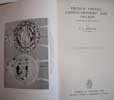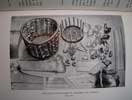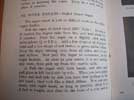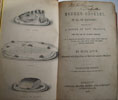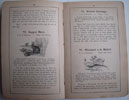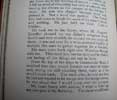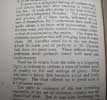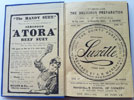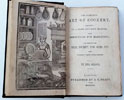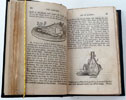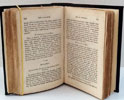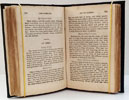THE BOOK OF ICES.
[FOURTEENTH THOUSAND.] INCLUDING CREAM AND WATER ICES, SORBETS, MOUSSES, ICED SOUFFLES, AND VARIOUS ICED DISHES, WITH NAMES IN FRENCH AND ENGLISH, AND VARIOUS COLOURED DESIGNES FOR ICES. BY A.B. MARSHALL. (Copyright.) REVISED AND ENLARGED EDITION. London: MARSHALL’S SCHOOL OF COOKERY, 32, MORTIMER STREET. SIMPKIN, MARSHALL, HAMILTON, KENT & CO., LIMITED, 4, STATIONERS’-HALL, COURT. [Price Half-a-Crown nett.]
180 x 120mm. n/d. Front paste-down and end-paper with lovely advertisements. Half-title. On verso advertisement for all Marshall’s books. [1] Frontispiece – one of the four coloured plates. Title page with tissue guard. [1] (1)vi-vii Contents. [1] (1)2-52. (1)54-76 Advertisements featuring wonderful illustrated drawings of Marshall’s ice-moulds, ice-pots and machines. (1)78-79 Index. On verso advertisement for all Marshall’s dry goods. [1] End-paper and paste-down with lovely advertisements. Original bright blue cloth cover with blind tolled lines and bright gilt writing. Internally very clean with the four coloured plates with tissue guards. A lovely copy of this very scarce much sought after thin volume. Earlier copies were published without the plates and had limited advertisements.
- Mrs. Agnes Bertha Marshall (born Walthamstow, Essex 1855 – died Brighton 1905) was a celebrity cook similar to today's television stars who hold cookery demonstrations and write books. Had there been television in her day, Mrs. Marshall would have without question, been a cookery pundit on the small screen. She was very well informed and always keen to adopt new technology. Agnes Marshall wrote four books: ‘The Book of Ices’ 1885; ‘Mrs. A.B. Marshall's Book of Cookery’ 1888; ‘Mrs. A.B. Marshall's Larger Cookery Book of Extra Recipes’ 1891; ‘Fancy Ices’ 1894; These are considered to be some of the finest books of their type ever written, especially those on ices, of which Mrs. Marshall was the Queen. Her recipes are clear, accurate, and well illustrated. She was very industrious, owning and running a domestic staff agency business, selling domestic and cooking equipment, and running a successful school of cookery in Welbeck St, London. She campaigned vigorously for better standards of food hygiene. Agnes toured extensively, lecturing and demonstrating her techniques to huge audiences. She even took her lectures to the United States in the summer of 1888. Two years earlier in 1886 she had started a magazine called "The Table". Mrs. Marshall can be credited with the invention of the ice cream edible cone, mentioned in her 1888 cookery book, the recipe being "cornets with cream". This predates American claims to the invention in 1904. There are no known earlier references to the edible ice cream cone, which nowadays we all take for granted. Her books stimulated demand for imported Norwegian ice, which was supplied from the building that is now the London Canal Museum. An exhibition at Syon House (1998) and at London Canal Museum (1999) told the story of her amazing life. Marshall has been neglected by historians, and is not famous today, unlike Mrs. Beeton, whose work benefited from commercial promotion long after her death. In contrast Mrs. Marshall's family did not make a long-term success of her business. Sadly, Agnes Marshall’s life ended too early. She died at age of forty nine recovering from injuries sustained from a riding accident. Marshall’s newspaper, company, and school survived her well into the twentieth century and her influence and opinions endured even longer.





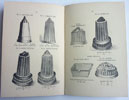
click on image to enlarge

Antiquarian category
ref number:
11135 





